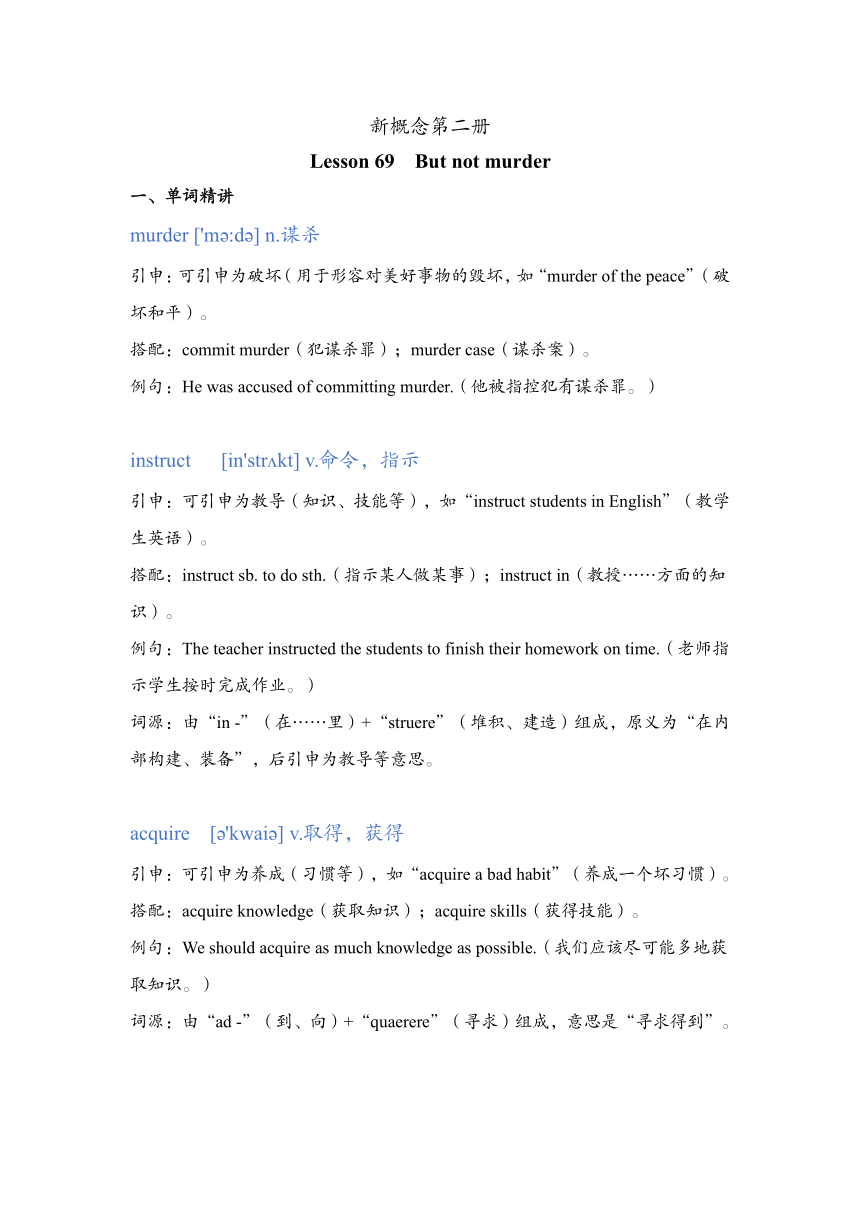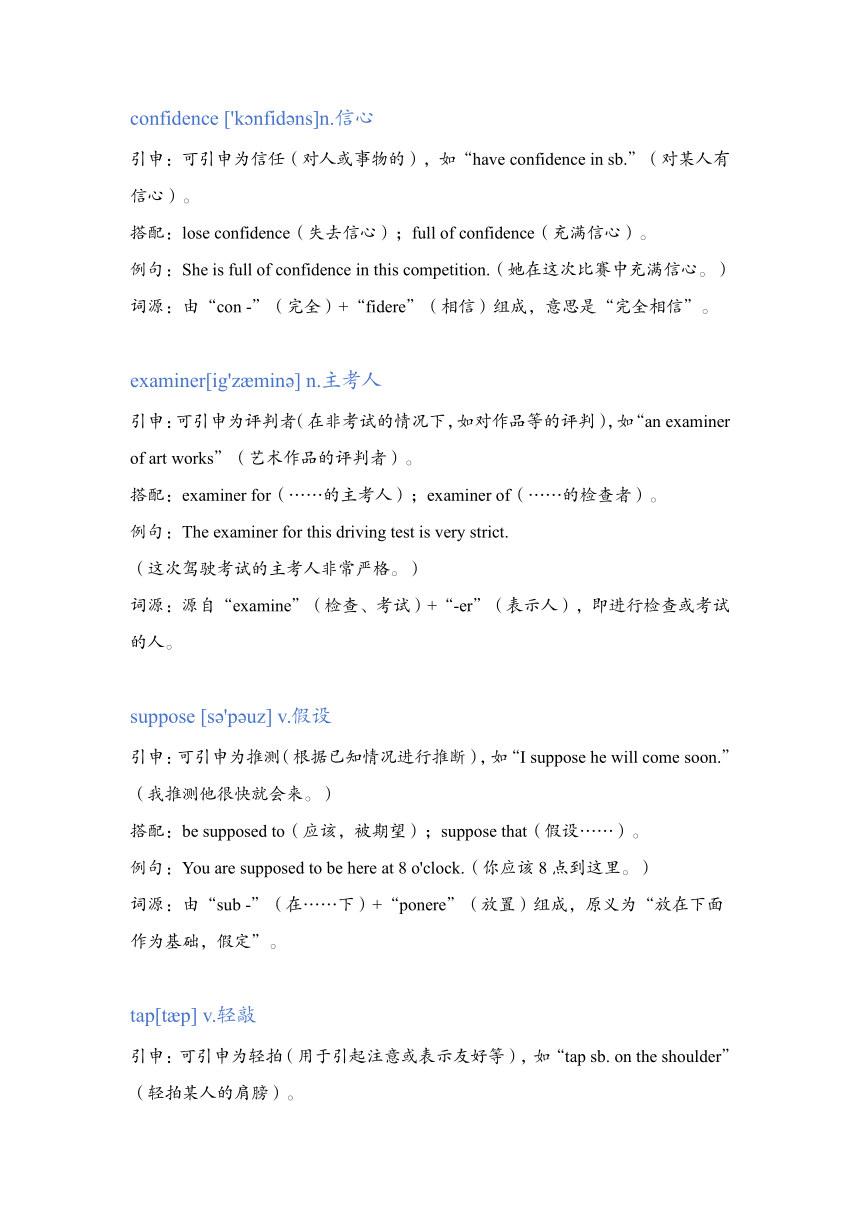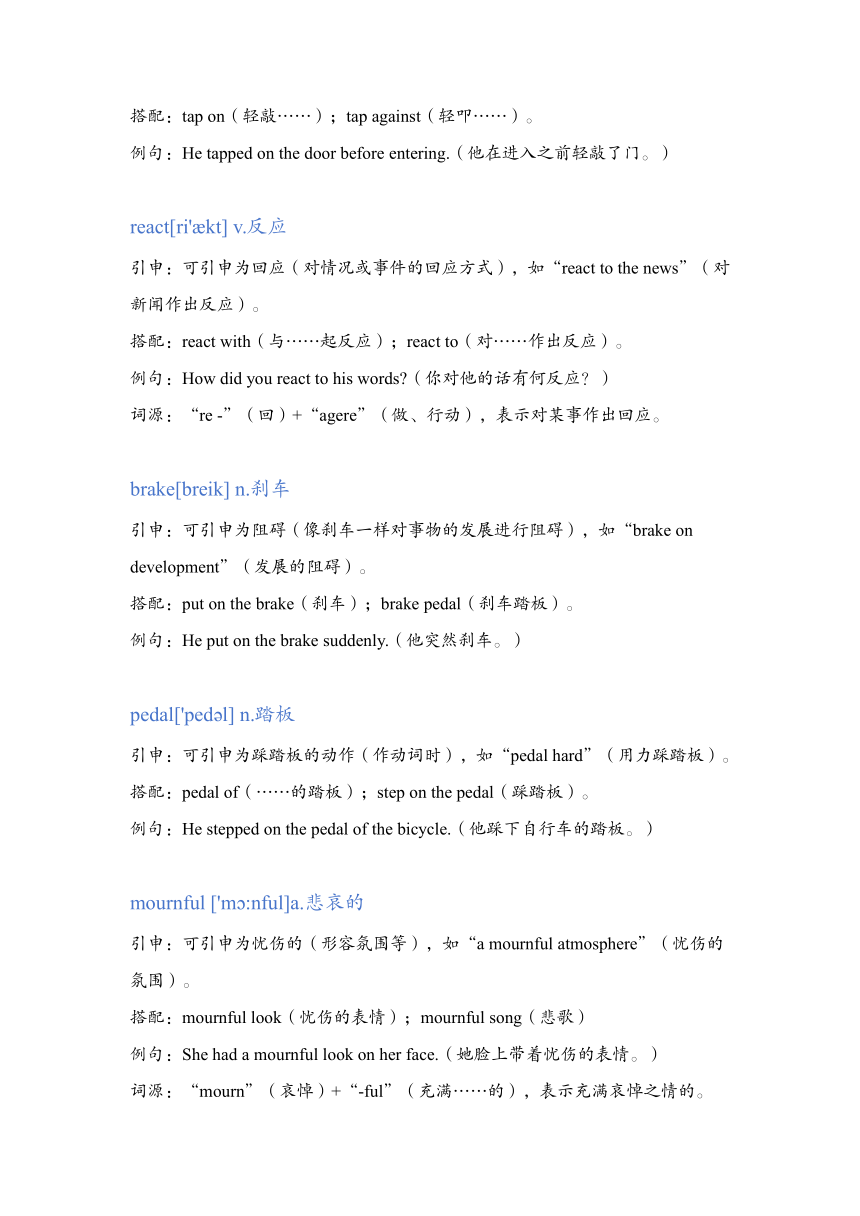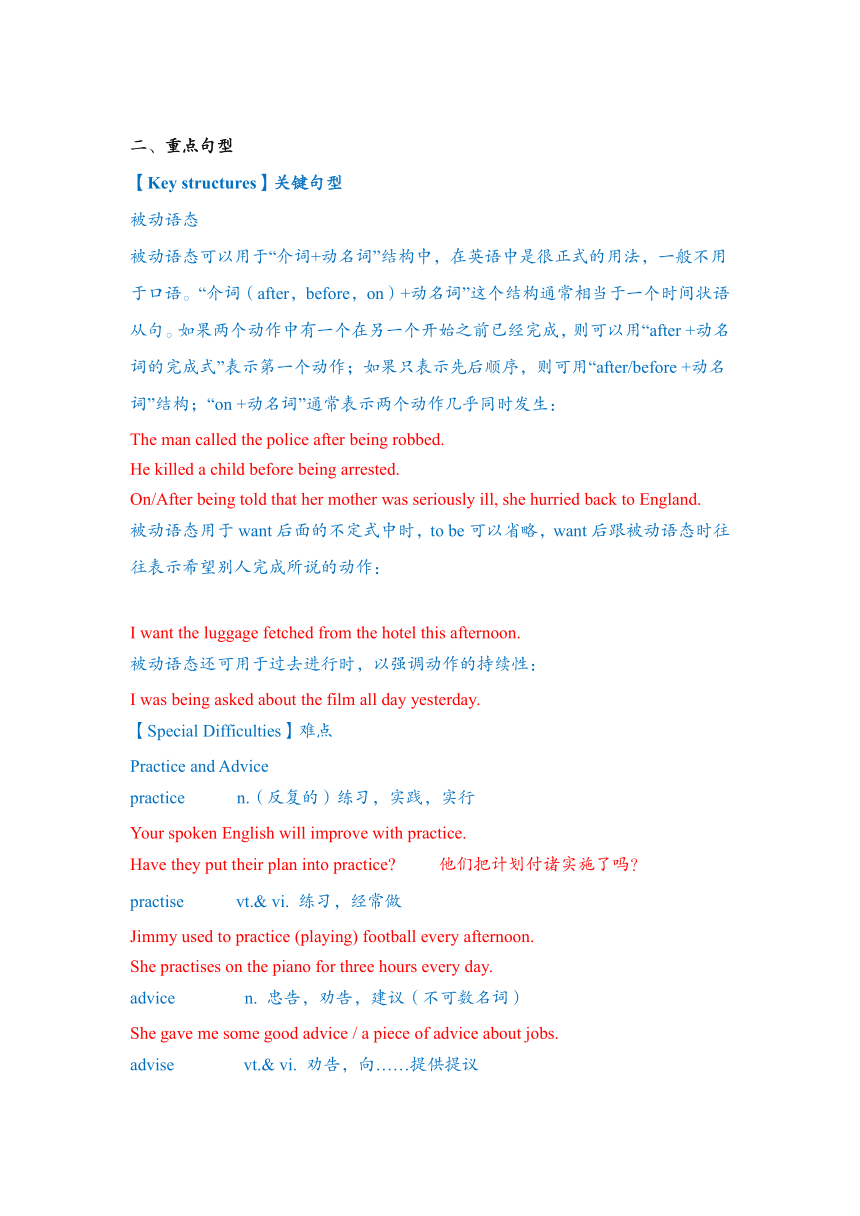新概念第二册Lesson 69 But not murder讲义
文档属性
| 名称 | 新概念第二册Lesson 69 But not murder讲义 |  | |
| 格式 | docx | ||
| 文件大小 | 126.3KB | ||
| 资源类型 | 教案 | ||
| 版本资源 | 新概念英语 | ||
| 科目 | 英语 | ||
| 更新时间 | 2024-11-24 21:23:32 | ||
图片预览




文档简介
新概念第二册
Lesson 69 But not murder
单词精讲
murder ['m :d ] n.谋杀
引申:可引申为破坏(用于形容对美好事物的毁坏,如“murder of the peace”(破坏和平)。
搭配:commit murder(犯谋杀罪);murder case(谋杀案)。
例句:He was accused of committing murder.(他被指控犯有谋杀罪。)
instruct [in'str kt] v.命令,指示
引申:可引申为教导(知识、技能等),如“instruct students in English”(教学生英语)。
搭配:instruct sb. to do sth.(指示某人做某事);instruct in(教授……方面的知识)。
例句:The teacher instructed the students to finish their homework on time.(老师指示学生按时完成作业。)
词源:由“in -”(在……里)+“struere”(堆积、建造)组成,原义为“在内部构建、装备”,后引申为教导等意思。
acquire [ 'kwai ] v.取得,获得
引申:可引申为养成(习惯等),如“acquire a bad habit”(养成一个坏习惯)。
搭配:acquire knowledge(获取知识);acquire skills(获得技能)。
例句:We should acquire as much knowledge as possible.(我们应该尽可能多地获取知识。)
词源:由“ad -”(到、向)+“quaerere”(寻求)组成,意思是“寻求得到”。
confidence ['k nfid ns]n.信心
引申:可引申为信任(对人或事物的),如“have confidence in sb.”(对某人有信心)。
搭配:lose confidence(失去信心);full of confidence(充满信心)。
例句:She is full of confidence in this competition.(她在这次比赛中充满信心。)
词源:由“con -”(完全)+“fidere”(相信)组成,意思是“完全相信”。
examiner[ig'z min ] n.主考人
引申:可引申为评判者(在非考试的情况下,如对作品等的评判),如“an examiner of art works”(艺术作品的评判者)。
搭配:examiner for(……的主考人);examiner of(……的检查者)。
例句:The examiner for this driving test is very strict.
(这次驾驶考试的主考人非常严格。)
词源:源自“examine”(检查、考试)+“-er”(表示人),即进行检查或考试的人。
suppose [s 'p uz] v.假设
引申:可引申为推测(根据已知情况进行推断),如“I suppose he will come soon.”(我推测他很快就会来。)
搭配:be supposed to(应该,被期望);suppose that(假设……)。
例句:You are supposed to be here at 8 o'clock.(你应该8点到这里。)
词源:由“sub -”(在……下)+“ponere”(放置)组成,原义为“放在下面作为基础,假定”。
tap[t p] v.轻敲
引申:可引申为轻拍(用于引起注意或表示友好等),如“tap sb. on the shoulder”(轻拍某人的肩膀)。
搭配:tap on(轻敲……);tap against(轻叩……)。
例句:He tapped on the door before entering.(他在进入之前轻敲了门。)
react[ri' kt] v.反应
引申:可引申为回应(对情况或事件的回应方式),如“react to the news”(对新闻作出反应)。
搭配:react with(与……起反应);react to(对……作出反应)。
例句:How did you react to his words (你对他的话有何反应?)
词源:“re -”(回)+“agere”(做、行动),表示对某事作出回应。
brake[breik] n.刹车
引申:可引申为阻碍(像刹车一样对事物的发展进行阻碍),如“brake on development”(发展的阻碍)。
搭配:put on the brake(刹车);brake pedal(刹车踏板)。
例句:He put on the brake suddenly.(他突然刹车。)
pedal['ped l] n.踏板
引申:可引申为踩踏板的动作(作动词时),如“pedal hard”(用力踩踏板)。
搭配:pedal of(……的踏板);step on the pedal(踩踏板)。
例句:He stepped on the pedal of the bicycle.(他踩下自行车的踏板。)
mournful ['m :nful]a.悲哀的
引申:可引申为忧伤的(形容氛围等),如“a mournful atmosphere”(忧伤的氛围)。
搭配:mournful look(忧伤的表情);mournful song(悲歌)
例句:She had a mournful look on her face.(她脸上带着忧伤的表情。)
词源:“mourn”(哀悼)+“-ful”(充满……的),表示充满哀悼之情的。
重点句型
【Key structures】关键句型
被动语态
被动语态可以用于“介词+动名词”结构中,在英语中是很正式的用法,一般不用于口语。“介词(after,before,on)+动名词”这个结构通常相当于一个时间状语从句。如果两个动作中有一个在另一个开始之前已经完成,则可以用“after +动名词的完成式”表示第一个动作;如果只表示先后顺序,则可用“after/before +动名词”结构;“on +动名词”通常表示两个动作几乎同时发生:
The man called the police after being robbed.
He killed a child before being arrested.
On/After being told that her mother was seriously ill, she hurried back to England.
被动语态用于want后面的不定式中时,to be可以省略,want后跟被动语态时往往表示希望别人完成所说的动作:
I want the luggage fetched from the hotel this afternoon.
被动语态还可用于过去进行时,以强调动作的持续性:
I was being asked about the film all day yesterday.
【Special Difficulties】难点
Practice and Advice
practice n.(反复的)练习,实践,实行
Your spoken English will improve with practice.
Have they put their plan into practice 他们把计划付诸实施了吗?
practise vt.& vi. 练习,经常做
Jimmy used to practice (playing) football every afternoon.
She practises on the piano for three hours every day.
advice n. 忠告,劝告,建议(不可数名词)
She gave me some good advice / a piece of advice about jobs.
advise vt.& vi. 劝告,向……提供提议
She advised me against going to the party. 她建议/劝我不要去参加聚会。
Enjoy, Entertain and Amuse
enjoy vt. 欣赏,喜爱,享受……之乐(后跟名词、动名词或反身代词,用于主动语态)
I enjoy swimming in summer.
We’re really enjoying ourselves.
entertain vt. 款待,招待,请客;使……快乐,给……娱乐(=amuse)
We often entertain friends at weekends.
Uncle Sam entertains/amuses the children for hours at a time.
萨姆叔叔一连好几小时地逗孩子们乐。
My children can entertain/amuse themselves for hours with telling stories to each other.
amuse vt. 逗乐,逗笑(常用于被动语态)
She was amused by her father’s funny stories.
His story amused the children very much.
课文精讲
Do you think that the writer passed his driving test Why ”
你认为作者能否通过驾照考试?为什么呢?
这是一个一般疑问句及其后续的追问。主句“Do you think”是一般现在时的一般疑问句,“that the writer passed his driving test”是宾语从句,其中“the writer”是主语,“passed”是谓语,“his driving test”是宾语。
I was being tested for a driving licence for the third time.
我第3次接受驾驶执照考试。
a driving licence 驾驶执照
“was being tested”:过去进行时的被动语态,表示当时正在被测试。
“for the third time”:第三次。
I had been asked to drive in heavy traffic and had done so successfully.
按照要求在车辆拥挤的路上驾驶,我圆满地完成了。
“had been asked”:过去完成时的被动语态,表示在过去某个时间之前被要求。
“drive in heavy traffic”:在繁忙的交通状况下驾驶。
“had done so”:“so”指代“drive in heavy traffic”,“had done”是过去完成时,表示在过去某个时间之前已经做了某事。
heavy adj. 大量的,多的,密集的
Traffic is heavier on this road than on the other one.
After having been instructed to drive out of town, I began to acquire confidence.”在接到把车开出城的指令后,我开始有了信心。
“After having been instructed”:在被指示之后,这是“after + 动名词的完成被动式”结构,表示动作发生在主句动作之前。
“drive out of town”:驾车出城。
“acquire confidence”:获得信心。
“Sure that I had passed, I was almost beginning to enjoy my test.”
确信我已通过考试,所以我几乎开始喜欢起这次考试。
“Sure that I had passed”:确信我已经通过,这是形容词短语作状语,表示原因,其中“that I had passed”是宾语从句。
“beginning to enjoy”:开始享受,“begin to do sth.”的进行时形式。
“my test”:我的考试。
“The examiner must have been pleased with my performance, for he smiled and said, 'Just one more thing, Mr. Eames.'”
主考人对我的驾驶想必是满意的,因为他微笑着说:“埃姆斯先生,只剩1项了。
“must have been pleased”:一定是满意的,“must + 完成式”表示对过去情况的推测。
“pleased with”:对……满意。
“my performance”:我的表现。
“for”:因为,在这里引导原因状语从句。
Let us suppose that a child suddenly crosses the road in front of you.”
让我们假设一个小孩子突然在你前面穿过马路。
“Let us suppose”:让我们假设,这是一个祈使句结构。
“suddenly crosses”:突然穿过,“suddenly”是副词,修饰“crosses”。
“in front of you”:在你面前。
“As soon as I tap on the window, you must stop within five feet.”
我一敲车窗,你必须把车停在5英尺之内。
“As soon as”:一……就……,引导时间状语从句。
“tap on the window”:轻敲窗户。
“must stop”:必须停止,“must”是情态动词,表示必要性。
“within five feet”:在五英尺之内。
“I continued driving and after some time, the examiner tapped loudly.”
我继续往前开着。过了一会儿,主考人砰砰地敲了起来。
“continued driving”:继续驾驶,“continue doing sth.”表示继续做某事。
“after some time”:过了一段时间。
“tapped loudly”:大声地敲击,“tapped”是“tap”的过去式,表示敲击,“loudly”是副词,修饰“tapped”。
“Though the sound could be heard clearly, it took me a long time to react.”
虽然声音听得很清楚,但我过了好一会儿才作出反应。
“Though”:虽然,引导让步状语从句。
“could be heard clearly”:能够被清楚地听到,这是含有情态动词的被动语态。
“took me a long time to react”:花费我很长时间做出反应,“it takes sb. some time to do sth.”是固定句型。
“I suddenly pressed the brake pedal and we were both thrown forward.”
我突然用力踩紧刹车踏板,结果我俩的身体都向前冲去。
“pressed the brake pedal”:踩刹车踏板,“pressed”是“press”的过去式,表示按压。
“were thrown forward”:被向前抛,这是一般过去时的被动语态。
“The examiner looked at me sadly. 'Mr. Eames,' he said, in a mournful voice, 'you have just killed that child!'”
主考人伤心地看着我。“埃姆斯先生,”他以悲伤的声调说,“你刚刚把那个小孩压死了!”
“looked at me sadly”:悲伤地看着我,“looked at”是“look at”的过去式,表示看,“sadly”是副词,修饰“looked at”。
“in a mournful voice”:用一种悲伤的声音。
“have just killed”:刚刚杀死,这是现在完成时,表示过去的动作对现在造成的影响。
Lesson 69 But not murder
单词精讲
murder ['m :d ] n.谋杀
引申:可引申为破坏(用于形容对美好事物的毁坏,如“murder of the peace”(破坏和平)。
搭配:commit murder(犯谋杀罪);murder case(谋杀案)。
例句:He was accused of committing murder.(他被指控犯有谋杀罪。)
instruct [in'str kt] v.命令,指示
引申:可引申为教导(知识、技能等),如“instruct students in English”(教学生英语)。
搭配:instruct sb. to do sth.(指示某人做某事);instruct in(教授……方面的知识)。
例句:The teacher instructed the students to finish their homework on time.(老师指示学生按时完成作业。)
词源:由“in -”(在……里)+“struere”(堆积、建造)组成,原义为“在内部构建、装备”,后引申为教导等意思。
acquire [ 'kwai ] v.取得,获得
引申:可引申为养成(习惯等),如“acquire a bad habit”(养成一个坏习惯)。
搭配:acquire knowledge(获取知识);acquire skills(获得技能)。
例句:We should acquire as much knowledge as possible.(我们应该尽可能多地获取知识。)
词源:由“ad -”(到、向)+“quaerere”(寻求)组成,意思是“寻求得到”。
confidence ['k nfid ns]n.信心
引申:可引申为信任(对人或事物的),如“have confidence in sb.”(对某人有信心)。
搭配:lose confidence(失去信心);full of confidence(充满信心)。
例句:She is full of confidence in this competition.(她在这次比赛中充满信心。)
词源:由“con -”(完全)+“fidere”(相信)组成,意思是“完全相信”。
examiner[ig'z min ] n.主考人
引申:可引申为评判者(在非考试的情况下,如对作品等的评判),如“an examiner of art works”(艺术作品的评判者)。
搭配:examiner for(……的主考人);examiner of(……的检查者)。
例句:The examiner for this driving test is very strict.
(这次驾驶考试的主考人非常严格。)
词源:源自“examine”(检查、考试)+“-er”(表示人),即进行检查或考试的人。
suppose [s 'p uz] v.假设
引申:可引申为推测(根据已知情况进行推断),如“I suppose he will come soon.”(我推测他很快就会来。)
搭配:be supposed to(应该,被期望);suppose that(假设……)。
例句:You are supposed to be here at 8 o'clock.(你应该8点到这里。)
词源:由“sub -”(在……下)+“ponere”(放置)组成,原义为“放在下面作为基础,假定”。
tap[t p] v.轻敲
引申:可引申为轻拍(用于引起注意或表示友好等),如“tap sb. on the shoulder”(轻拍某人的肩膀)。
搭配:tap on(轻敲……);tap against(轻叩……)。
例句:He tapped on the door before entering.(他在进入之前轻敲了门。)
react[ri' kt] v.反应
引申:可引申为回应(对情况或事件的回应方式),如“react to the news”(对新闻作出反应)。
搭配:react with(与……起反应);react to(对……作出反应)。
例句:How did you react to his words (你对他的话有何反应?)
词源:“re -”(回)+“agere”(做、行动),表示对某事作出回应。
brake[breik] n.刹车
引申:可引申为阻碍(像刹车一样对事物的发展进行阻碍),如“brake on development”(发展的阻碍)。
搭配:put on the brake(刹车);brake pedal(刹车踏板)。
例句:He put on the brake suddenly.(他突然刹车。)
pedal['ped l] n.踏板
引申:可引申为踩踏板的动作(作动词时),如“pedal hard”(用力踩踏板)。
搭配:pedal of(……的踏板);step on the pedal(踩踏板)。
例句:He stepped on the pedal of the bicycle.(他踩下自行车的踏板。)
mournful ['m :nful]a.悲哀的
引申:可引申为忧伤的(形容氛围等),如“a mournful atmosphere”(忧伤的氛围)。
搭配:mournful look(忧伤的表情);mournful song(悲歌)
例句:She had a mournful look on her face.(她脸上带着忧伤的表情。)
词源:“mourn”(哀悼)+“-ful”(充满……的),表示充满哀悼之情的。
重点句型
【Key structures】关键句型
被动语态
被动语态可以用于“介词+动名词”结构中,在英语中是很正式的用法,一般不用于口语。“介词(after,before,on)+动名词”这个结构通常相当于一个时间状语从句。如果两个动作中有一个在另一个开始之前已经完成,则可以用“after +动名词的完成式”表示第一个动作;如果只表示先后顺序,则可用“after/before +动名词”结构;“on +动名词”通常表示两个动作几乎同时发生:
The man called the police after being robbed.
He killed a child before being arrested.
On/After being told that her mother was seriously ill, she hurried back to England.
被动语态用于want后面的不定式中时,to be可以省略,want后跟被动语态时往往表示希望别人完成所说的动作:
I want the luggage fetched from the hotel this afternoon.
被动语态还可用于过去进行时,以强调动作的持续性:
I was being asked about the film all day yesterday.
【Special Difficulties】难点
Practice and Advice
practice n.(反复的)练习,实践,实行
Your spoken English will improve with practice.
Have they put their plan into practice 他们把计划付诸实施了吗?
practise vt.& vi. 练习,经常做
Jimmy used to practice (playing) football every afternoon.
She practises on the piano for three hours every day.
advice n. 忠告,劝告,建议(不可数名词)
She gave me some good advice / a piece of advice about jobs.
advise vt.& vi. 劝告,向……提供提议
She advised me against going to the party. 她建议/劝我不要去参加聚会。
Enjoy, Entertain and Amuse
enjoy vt. 欣赏,喜爱,享受……之乐(后跟名词、动名词或反身代词,用于主动语态)
I enjoy swimming in summer.
We’re really enjoying ourselves.
entertain vt. 款待,招待,请客;使……快乐,给……娱乐(=amuse)
We often entertain friends at weekends.
Uncle Sam entertains/amuses the children for hours at a time.
萨姆叔叔一连好几小时地逗孩子们乐。
My children can entertain/amuse themselves for hours with telling stories to each other.
amuse vt. 逗乐,逗笑(常用于被动语态)
She was amused by her father’s funny stories.
His story amused the children very much.
课文精讲
Do you think that the writer passed his driving test Why ”
你认为作者能否通过驾照考试?为什么呢?
这是一个一般疑问句及其后续的追问。主句“Do you think”是一般现在时的一般疑问句,“that the writer passed his driving test”是宾语从句,其中“the writer”是主语,“passed”是谓语,“his driving test”是宾语。
I was being tested for a driving licence for the third time.
我第3次接受驾驶执照考试。
a driving licence 驾驶执照
“was being tested”:过去进行时的被动语态,表示当时正在被测试。
“for the third time”:第三次。
I had been asked to drive in heavy traffic and had done so successfully.
按照要求在车辆拥挤的路上驾驶,我圆满地完成了。
“had been asked”:过去完成时的被动语态,表示在过去某个时间之前被要求。
“drive in heavy traffic”:在繁忙的交通状况下驾驶。
“had done so”:“so”指代“drive in heavy traffic”,“had done”是过去完成时,表示在过去某个时间之前已经做了某事。
heavy adj. 大量的,多的,密集的
Traffic is heavier on this road than on the other one.
After having been instructed to drive out of town, I began to acquire confidence.”在接到把车开出城的指令后,我开始有了信心。
“After having been instructed”:在被指示之后,这是“after + 动名词的完成被动式”结构,表示动作发生在主句动作之前。
“drive out of town”:驾车出城。
“acquire confidence”:获得信心。
“Sure that I had passed, I was almost beginning to enjoy my test.”
确信我已通过考试,所以我几乎开始喜欢起这次考试。
“Sure that I had passed”:确信我已经通过,这是形容词短语作状语,表示原因,其中“that I had passed”是宾语从句。
“beginning to enjoy”:开始享受,“begin to do sth.”的进行时形式。
“my test”:我的考试。
“The examiner must have been pleased with my performance, for he smiled and said, 'Just one more thing, Mr. Eames.'”
主考人对我的驾驶想必是满意的,因为他微笑着说:“埃姆斯先生,只剩1项了。
“must have been pleased”:一定是满意的,“must + 完成式”表示对过去情况的推测。
“pleased with”:对……满意。
“my performance”:我的表现。
“for”:因为,在这里引导原因状语从句。
Let us suppose that a child suddenly crosses the road in front of you.”
让我们假设一个小孩子突然在你前面穿过马路。
“Let us suppose”:让我们假设,这是一个祈使句结构。
“suddenly crosses”:突然穿过,“suddenly”是副词,修饰“crosses”。
“in front of you”:在你面前。
“As soon as I tap on the window, you must stop within five feet.”
我一敲车窗,你必须把车停在5英尺之内。
“As soon as”:一……就……,引导时间状语从句。
“tap on the window”:轻敲窗户。
“must stop”:必须停止,“must”是情态动词,表示必要性。
“within five feet”:在五英尺之内。
“I continued driving and after some time, the examiner tapped loudly.”
我继续往前开着。过了一会儿,主考人砰砰地敲了起来。
“continued driving”:继续驾驶,“continue doing sth.”表示继续做某事。
“after some time”:过了一段时间。
“tapped loudly”:大声地敲击,“tapped”是“tap”的过去式,表示敲击,“loudly”是副词,修饰“tapped”。
“Though the sound could be heard clearly, it took me a long time to react.”
虽然声音听得很清楚,但我过了好一会儿才作出反应。
“Though”:虽然,引导让步状语从句。
“could be heard clearly”:能够被清楚地听到,这是含有情态动词的被动语态。
“took me a long time to react”:花费我很长时间做出反应,“it takes sb. some time to do sth.”是固定句型。
“I suddenly pressed the brake pedal and we were both thrown forward.”
我突然用力踩紧刹车踏板,结果我俩的身体都向前冲去。
“pressed the brake pedal”:踩刹车踏板,“pressed”是“press”的过去式,表示按压。
“were thrown forward”:被向前抛,这是一般过去时的被动语态。
“The examiner looked at me sadly. 'Mr. Eames,' he said, in a mournful voice, 'you have just killed that child!'”
主考人伤心地看着我。“埃姆斯先生,”他以悲伤的声调说,“你刚刚把那个小孩压死了!”
“looked at me sadly”:悲伤地看着我,“looked at”是“look at”的过去式,表示看,“sadly”是副词,修饰“looked at”。
“in a mournful voice”:用一种悲伤的声音。
“have just killed”:刚刚杀死,这是现在完成时,表示过去的动作对现在造成的影响。
同课章节目录
